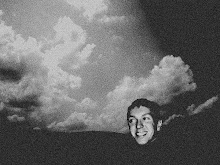I should probably change the "Daily" part of "Daily Dose" to "Bimonthly". When I think of something interesting to write, I have no time to. When I have time to, I can never think of anything interesting to write. I don't have a preliminary guideline for what I'm about to write. I just felt like writing. I'll just start writing aimlessly and hope it appeals to at least one person besides myself.
There were a few things I had wanted to write about during these past two and a half months. I'm sure I won't be able to remember every single thing during this entry, nor would I have the time to write about them all in the amount of detail I so usually go into about things.
Firstly, Synecdoche, New York. This is definitely a film to watch. If you haven't seen this, see it. I'm not going to sit here and convince you about how much you'll enjoy it as much as I did. Chances are you probably won't. I would like to persuade you to see it by letting you know that this film had, by far, the most intense effect on me, more so than any other film I'd ever seen before it. I've gone to the Metropolitan Museum of Art twice within the past two weeks. The first time was with my parents. On the day I had gone with my parents, I got into a conversation I've recently often found myself in with my father about thinking in linear terms. There was a painting near the Jackson Pollocks at the top floor of the modern art section that ignited this. I can't recall the name of the artist or the painting. I'll be sure to write it down and post it for a later entry. Basically, it was what I would refer to as "Perspectiveless". The painting was not so much abstract where you couldn't name or identify a definite object. The painting had recognizable (although obscure) images of people, pieces of factory assembly lines, staircases and several other items. That was definite and not interpretive. I refer to this painting as "Perspectiveless" because the artist had placed these objects in a manner that causes your eye to face an obstacle real life rarely throws at it. It was not clear whether the stairs were going up, down, left right, getting narrower, getting broader. One man could have been seen as being on top of something, to the left of it, to the right of it, underneath it or even in it. You could perceive the painting in any of these ways. There was no definite perspective conveyed nor intended.
I believe that's what Charlie Kaufman (writer/director of Synecdoche, New York) was trying to do with the film. Purposely inserting blatant metaphorical, yet, at the same time, concrete imagery, such as a constant fire burning in a woman's house throughout the movie, Kaufman shows each viewer his or her own each individual clear reflection on life. This film can't be viewed in linear terms, just as the painting can't. We travel through life with this program constantly running in our brains telling us that everything has a beginning and an end because that's what makes sense in linear terms. Everything has a right and a wrong and nothing else because that's what makes sense in linear terms. Synecdoche, New York has nothing to show but pure life, pure existence in their purest forms. Before I go on any further, just go see the movie. It's amazing. If you know me, I own it. We can watch it together if you'd like.
What I've Been Up To
12 years ago
